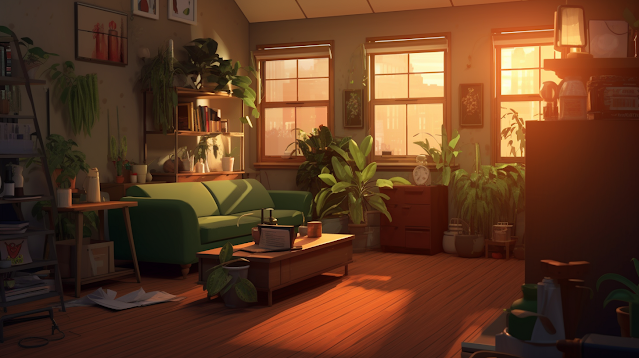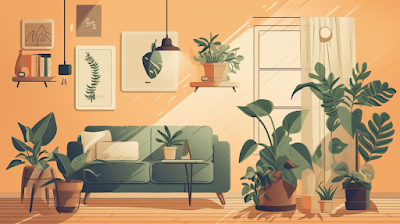 |
| Eco-Design For A Greener Home |
Are you looking for ways to make your home more eco-friendly? With just a few simple changes, you can reduce your environmental impact and create a healthier living space for yourself and your family.
In this article, we'll provide you with seven easy eco-design tips that you can implement in your home today.
First, we'll focus on eco-friendly interior design ideas, including using low-VOC paints, investing in energy-efficient lighting, and purchasing secondhand furniture. These small changes can make a big difference in reducing your carbon footprint and promoting sustainability.
Next, we'll discuss ways to reduce your environmental impact, such as using reusable shopping bags and water bottles and reducing your overall consumption habits.
Finally, we'll cover water conservation techniques, which are essential for protecting our planet's most precious resource and saving money on your water bill.
By following these tips, you can create a greener home that benefits both the environment and your own well-being.
Key Takeaways
- Choosing sustainable materials and energy-efficient lighting can significantly reduce environmental impact
- Opting for furniture and decor that can be repurposed or recycled promotes a circular economy and reduces waste
- Low-VOC paints and sustainably-sourced natural materials reduce manufacturing impact and promote a healthier living space
- Water conservation techniques, such as modern plumbing fixtures and rainwater collection systems, protect the environment and preserve resources.
Eco-Friendly Interior Design Ideas
You can easily embrace eco-friendly interior design ideas by using low-VOC paints, investing in energy-efficient lighting, and incorporating sustainably-sourced natural materials.
Using sustainable materials like bamboo, reclaimed wood, and organic cotton not only reduces the environmental impact of manufacturing, but it also promotes a healthier living space for you and your family. These materials are free from harmful chemicals and synthetic materials that can release volatile organic compounds (VOCs) and contribute to poor indoor air quality.
Implementing energy-efficient lighting is another way to reduce your carbon footprint and lower your energy bills. Switching to LED lights can save up to 80% more energy compared to traditional incandescent bulbs, and they last longer too.
You can also use natural lighting by strategically placing windows and skylights to maximize sunlight and minimize the need for artificial lighting during the day. By making these simple changes to your home's interior design, you can create a greener and healthier living space for yourself and the planet.
Reducing Environmental Impact
Choose furniture and decor that can be repurposed or recycled to help reduce your environmental impact. By opting for pieces that can be easily transformed into something new, you can reduce waste and keep materials out of landfills.
Additionally, choosing sturdier pieces that can withstand wear and tear can help reduce your consumption habits. Here are three sustainable product choices to consider when it comes to furniture and decor:
Look for furniture made from reclaimed or sustainably-sourced wood. This not only reduces the demand for new materials, but it also gives new life to old wood that may have otherwise been discarded.
Choose decor made from recycled materials, such as glass or metal. These materials can be repurposed again and again, without losing their quality or durability.
Consider upcycling old furniture or decor. By giving new life to something old, you can reduce waste and create a unique piece that reflects your personal style.
Green lifestyle habits don't have to be complicated - small changes in the products you buy can make a big difference in reducing your environmental impact. By choosing furniture and decor that can be repurposed or recycled, you can take steps towards a more sustainable lifestyle.
Sustainable product choices not only benefit the environment, but they also promote a circular economy and reduce waste. Making conscious decisions about the products you buy can make a positive impact on your home and the planet.
 |
| Eco-Design For A Greener Home |
Water Conservation Techniques
Implementing water conservation techniques in your home can help reduce your environmental impact and contribute to a more sustainable lifestyle. One way to conserve water is by investing in modern water-saving plumbing fixtures, such as low-flow showerheads and faucets. These fixtures use less water without sacrificing performance, which can significantly reduce your household's water usage. For example, a low-flow showerhead can save up to 2,700 gallons of water per year, while a low-flow toilet can save up to 16,500 gallons of water per year.
Another way to conserve water is by incorporating drought-resistant landscaping in your garden. These plants require less water to survive and thrive, which can help reduce your household's overall water consumption. Some examples of drought-resistant plants include succulents, cacti, and lavender. You can also install a rainwater collection system in your garden to collect and reuse rainwater for irrigation purposes. By implementing these water conservation techniques, you can do your part in protecting the environment and preserving our planet's precious resources.
Frequently Asked Questions
What are some eco-friendly options for flooring in a home?
For eco-friendly flooring, consider bamboo or cork. Both are sustainable, durable, and easy to maintain. Add recycled material rugs for extra style and sustainability. Reducing your environmental impact can be stylish and easy.
How can one incorporate sustainability into their home's decor?
Incorporate sustainability into your home's decor by choosing eco-friendly furniture options and sustainable lighting choices. Look for pieces made from natural materials and invest in energy-efficient lighting to reduce your environmental impact.
Are there any eco-friendly alternatives to traditional air conditioning systems?
Yes, there are eco-friendly alternatives to traditional air conditioning systems. Consider solar powered cooling or natural ventilation. Solar powered systems use renewable energy while natural ventilation utilizes outside air for a healthier and more energy-efficient home.
What are some ways to reduce energy consumption in the kitchen?
Reduce energy consumption in your kitchen by investing in smart appliances and using energy efficient lighting. Choose appliances with energy star ratings, and opt for LED lighting to save money and reduce your carbon footprint.
How can one ensure the sustainability of their landscaping and outdoor spaces?
Ensure the sustainability of your landscaping and outdoor spaces with eco-friendly gardening practices and sustainable outdoor furniture. Choose native plants, use rain barrels, and opt for furniture made from recycled materials to reduce your environmental impact.

.png)
%20(1).png)
Comments
Post a Comment